The global ball-picking robot market, valued at USD 107.0 million in 2025, is expected to grow to USD 262.8 million by 2035, marking a total increase of USD 155.8 million, at a CAGR of 9.4%. The market size is expected to grow by nearly 2.46X during the same period, supported by increasing demand for sports automation technologies, growing adoption of robotic solutions in athletic training, and rising focus on efficient practice management across diverse sports and recreational applications.
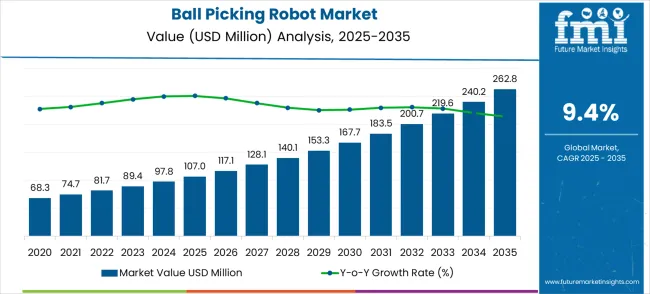
Between 2025 and 2030, the ball-picking robot market is projected to expand from USD 107.0 million to USD 167.7 million, resulting in a value increase of USD 60.7 million, which represents 39.0% of the total forecast growth for the decade. This phase of development will be shaped by increasing sports facility automation, rising adoption of AI-powered training tools, and growing demand for labor-saving solutions that enhance practice efficiency and training quality. Sports facilities and professional athletes are expanding their use of ball-picking robots to address the growing demand for automated training support and practice optimization.
| Metric | Value |
|---|---|
| Estimated Value in (2025E) | USD 107.0 million |
| Forecast Value in (2035F) | USD 262.8 million |
| Forecast CAGR (2025 to 2035) | 9.4% |
The sports industry holds the largest share, around 40-45%, with these robots being used in facilities for tennis, soccer, and golf to automate the process of collecting balls during practice sessions, enhancing efficiency and reducing labor. The leisure and entertainment sector follows closely with 20-25%, where ball picking robots are used in amusement parks, bowling alleys, and arcades to improve customer experience by maintaining cleanliness and providing automated services. The manufacturing and warehousing segment accounts for about 15-18%, as these robots are deployed in warehouses and assembly lines to handle small objects and parts, optimizing operations through automation. The education and research sector contributes 10-12%, where these robots are used in robotics labs and competitions, helping students and researchers learn about automation and robotics technology. The agriculture sector, though a smaller segment at 5-8%, is beginning to use ball picking robots for efficient fruit and vegetable harvesting, particularly for round-shaped fruits like tomatoes.
Market expansion is being supported by the increasing global focus on sports training optimization and the corresponding need for automated solutions that can enhance practice efficiency, reduce manual labor, and improve training quality across various tennis, golf, and recreational sports applications. Modern sports facilities and professional athletes are increasingly focused on implementing automation solutions that can streamline practice sessions, maximize training time, and provide consistent performance in demanding sports environments. Ball-picking robots' proven ability to deliver autonomous ball collection, enhance training efficiency, and support practice optimization makes them essential equipment for contemporary sports training and facility management.
The growing focus on sports technology and training innovation is driving demand for ball-picking robots that can support advanced training methodologies, enable data collection, and facilitate comprehensive practice management. Sports facilities' preference for automation solutions that combine operational efficiency with reliability and ease of use is creating opportunities for innovative ball-picking robot implementations. The rising influence of AI and smart sports technologies is also contributing to increased adoption of ball-picking robots that can provide intelligent operation without compromising training effectiveness or user experience.
The market is segmented by sports type, application, and region. By sports type, the market is divided into tennis ball-picking robots and golf ball-picking robots. Based on the application, the market is categorized into professional athletes and ordinary players. Regionally, the market is divided into Asia Pacific, North America, Europe, Latin America, and the Middle East & Africa.
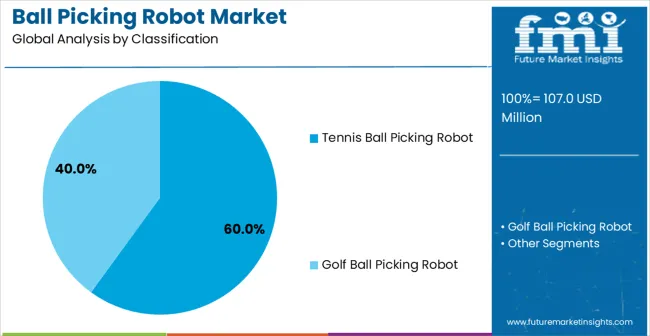
The tennis ball picking robot segment is projected to maintain its leading position in the ball picking robot market in 2025, capturing 60% of the market share. Tennis coaches and facility managers increasingly adopt these robots for their efficient court coverage, reliable ball collection, and adaptability across various training scenarios and court configurations. The technology's proven effectiveness in optimizing ball collection directly addresses the needs of tennis training, providing consistent support in diverse applications. This segment has become the foundation of modern tennis training automation, with strong market penetration and a proven performance record in tennis facilities worldwide. Ongoing investments in automated systems continue to drive adoption among coaches and facility operators, making tennis ball picking robots integral to training effectiveness and operational efficiency in tennis facilities.
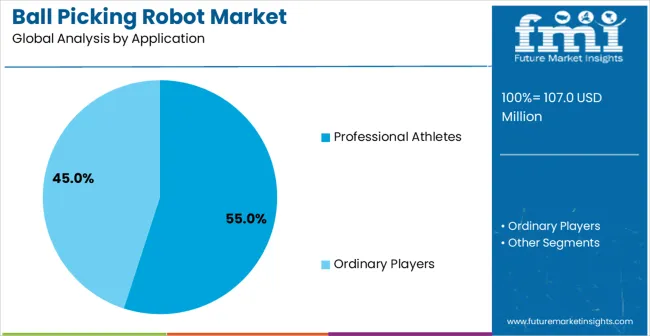
The professional athletes' application segment is projected to account for the largest share of ball-picking robot demand in 2025, with 55% of the market. This segment drives the adoption of automated equipment in professional tennis academies, golf training facilities, and elite sports programs. Professional athletes prefer these robots for their ability to optimize training time, provide consistent ball availability, and enhance training sessions for high-performance development. Ball-picking robots are essential tools for modern sports training, offering both efficiency and training benefits. Continuous innovation in training technologies and specialized robotic systems further strengthens their role in professional sports. As training becomes more sophisticated and efficiency needs increase, the professional athletes’ segment will remain dominant in the market, supporting high-level performance and automation strategies.
The ball-picking robot market is advancing rapidly due to increasing demand for sports automation and growing adoption of robotic technologies that provide enhanced training efficiency and operational convenience across diverse tennis, golf, and recreational sports applications. The market faces challenges, including high equipment costs and initial investment requirements, technical complexity in navigation and ball detection systems, and maintenance requirements for outdoor operation in various weather conditions. Innovation in AI integration and autonomous navigation continues to influence product development and market expansion patterns.
The growing adoption of artificial intelligence and machine learning technologies is enabling ball-picking robots to achieve superior navigation accuracy, enhanced ball detection capabilities, and autonomous operation for comprehensive training support applications. AI-enabled robotic systems provide improved operational efficiency while allowing more intelligent decision-making and consistent performance across various sports environments and training scenarios. Manufacturers are increasingly recognizing the competitive advantages of AI integration for operational differentiation and training optimization.
Modern ball-picking robot manufacturers are incorporating multi-sport functionality and advanced navigation technologies to enhance operational versatility, enable comprehensive sports facility support, and provide superior automation through intelligent path planning and obstacle avoidance systems. These technologies improve operational effectiveness while enabling new applications, including multi-court operation and adaptive training support. Advanced navigation integration also allows facilities to support comprehensive sports automation and training optimization beyond traditional single-sport ball collection approaches.
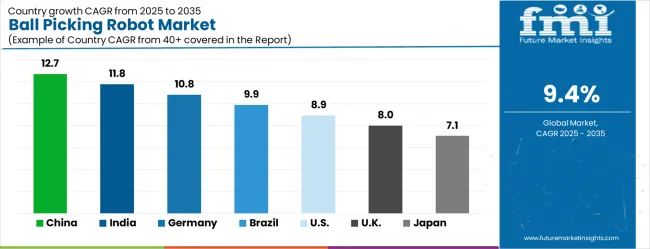
| Country | CAGR (2025-2035) |
|---|---|
| China | 12.7% |
| India | 11.8% |
| Germany | 10.8% |
| Brazil | 9.9% |
| USA | 8.9% |
| UK | 8.0% |
| Japan | 7.1% |
The ball-picking robot market is experiencing exceptional growth globally, with China leading at a 12.7% CAGR through 2035, driven by the expanding sports industry, growing robotics technology development, and significant investment in sports facility modernization and automation technology advancement. India follows at 11.8%, supported by rapid sports infrastructure development, increasing adoption of sports technology, and growing investment in recreational facility automation. Germany shows growth at 10.8%, emphasizing precision robotics and advanced sports technology development. Brazil records 9.9%, focusing on sports facility modernization and recreational technology adoption initiatives. The USA demonstrates 8.9% growth, supported by the established sports industry and focus on training technology advancement. The UK exhibits 8.0% growth, emphasizing sports innovation and facility automation technologies. Japan shows 7.1% growth, supported by advanced robotics technologies and precision automation system development.
The report covers an in-depth analysis of 40+ countries with top-performing countries highlighted below.
The ball picking robot market is show significant growth, with a projected CAGR of 12.7% from 2025 to 2035. The country’s rapid industrialization, along with advancements in robotics and automation technologies, is driving demand for ball picking robots in various sectors, including sports, logistics, and agriculture. China's large manufacturing base also provides ample opportunities for robotic solutions to improve operational efficiency and reduce labor costs. The growing adoption of automation in sports training facilities, stadiums, and warehouses is a key factor in market growth. China’s government initiatives to encourage automation and robotics research are further propelling the development of ball picking robots.
Demand for ball picking robot in India is expected to expand at a CAGR of 11.8% from 2025 to 2035. As the country focuses on improving its infrastructure and industrial capabilities, the adoption of automation technologies is increasing, especially in sports and warehousing industries. The increasing demand for efficient labor-saving solutions in various sectors, particularly in sports training and events, is a driving force. India’s emerging technological landscape, combined with growing awareness of automation’s benefits, is paving the way for the adoption of robotic solutions like ball picking robots.
The ball picking robot market in Germany is growing at a CAGR of 10.8% from 2025 to 2035. Known for its technological prowess and strong manufacturing sector, Germany is witnessing an increased adoption of robotics in various industries, including sports and logistics. The demand for ball picking robots is rising as sports clubs, training facilities, and sports events seek to enhance efficiency and reduce manual labor. The country’s strong industrial automation sector is accelerating the development and integration of robotic technologies. Germany’s commitment to technological innovation and smart manufacturing is further supporting this market’s growth.
The ball picking robot market in Brazil is expected to expand at a CAGR of 9.9% from 2025 to 2035. Brazil's expanding sports industry, along with the growing adoption of robotics for operational efficiency, is driving the demand for ball picking robots. The country’s investment in sports infrastructure and the rising number of sports events present opportunities for increased automation. Moreover, as Brazil’s industrial sector modernizes, the need for automation in warehouses, training facilities, and sports complexes is increasing. Ball picking robots are becoming essential in reducing labor costs and improving productivity in these industries.
The ball picking robot market in the USA is expected to grow at a CAGR of 8.9% from 2025 to 2035. The USA market benefits from advanced technological capabilities, particularly in robotics and AI. The demand for ball picking robots is rising due to their application in sports training centers, events, and warehouses, where there is a push to minimize labor costs and maximize efficiency. The increasing focus on automation, along with ongoing advancements in robotic technology, is driving the market in the USA. Government support for research and innovation in robotics is contributing to market growth.
The ball picking robot market in the UK is expanding at a CAGR of 8.0% from 2025 to 2035. The market growth is fueled by the increasing demand for automation in the sports sector, especially in sports clubs, training centers, and sports events. The UK is also investing in robotics and automation technologies to enhance efficiency in various industries, including warehousing and logistics. The growing trend of adopting robotic solutions to reduce labor costs and improve operational performance in sports facilities is expected to drive market growth.
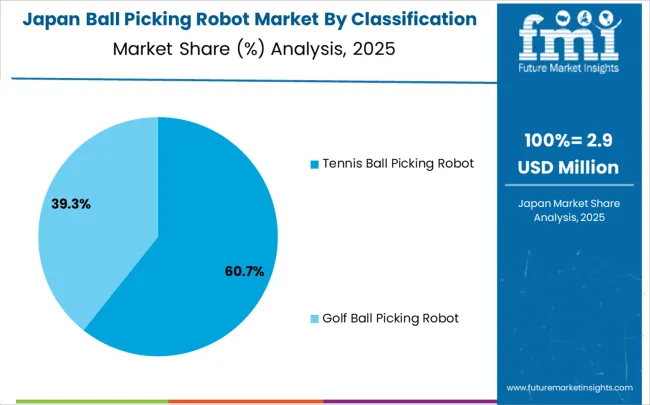
The ball picking robot market is forecasted to grow at a CAGR of 7.1% from 2025 to 2035. The country’s strong robotics and automation culture is driving the adoption of ball picking robots in various industries, particularly in sports and logistics. Japan’s sports industry, including events and training centers, is increasingly adopting robotic solutions to reduce the manual labor involved in ball retrieval. With advancements in AI and robotics, Japan’s market is seeing increased demand for more precise, efficient, and cost-effective ball picking robots.
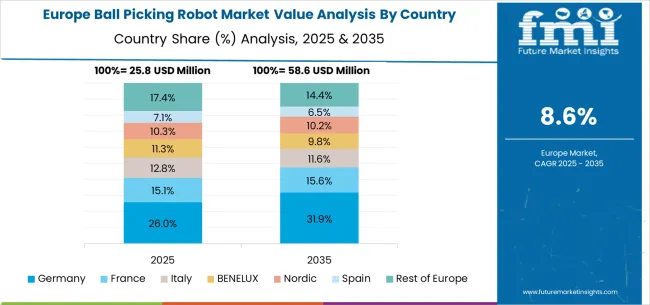
The ball-picking robot market in Europe is projected to grow from USD 37.7 million in 2025 to USD 84.5 million by 2035, registering a CAGR of 8.4% over the forecast period. Germany is expected to maintain its leadership position with a 27.0% market share in 2025, moderating slightly to 26.8% by 2035, supported by its strong robotics sector, advanced sports technology industry, and comprehensive sports facility infrastructure serving major European markets.
The United Kingdom follows with 21.5% in 2025, projected to reach 21.3% by 2035, driven by an established sports innovation focus, a comprehensive facility automation framework, and advanced sports technology programs. France holds 18.0% in 2025, rising to 18.2% by 2035, supported by sports facility development and growing adoption of advanced sports automation technologies. Italy commands 13.5% in 2025, projected to reach 13.6% by 2035, while Spain accounts for 9.0% in 2025, expected to reach 9.1% by 2035. The Netherlands maintains a 4.0% share in 2025, growing to 4.1% by 2035. The Rest of Europe region, including Nordic countries, Eastern Europe, and other markets, is anticipated to maintain its position, holding its collective share at 7.0% by 2035, attributed to increasing sports facility modernization and growing sports automation adoption across emerging recreational markets implementing advanced sports technology standards.
The ball-picking robot market is characterized by competition among established robotics companies, specialized sports technology manufacturers, and integrated sports automation solution providers. Companies are investing in advanced robotics research, AI integration, navigation technology development, and comprehensive product portfolios to deliver reliable, intelligent, and efficient ball-picking robot solutions. Innovation in autonomous navigation, multi-sport functionality, and smart connectivity is central to strengthening market position and competitive advantage.
Korechi leads the market with specialized sports robotics solutions, offering advanced ball-picking robots with a focus on tennis applications and autonomous operation capabilities. Range Servant provides comprehensive sports automation equipment with an focus on golf course applications and facility integration. Wayrobo delivers innovative robotics solutions with a focus on multi-sport functionality and intelligent automation. Tennibot specializes in tennis court automation with focus on professional training support and autonomous ball collection. Relox Robotics focuses on advanced sports robotics with an focus on AI integration and navigation technology. ECHO Robotics offers comprehensive outdoor robotics solutions with an focus on sports and recreational applications.
Ball-picking robots represent an emerging sports automation segment within recreational and professional athletics, projected to grow from USD 107.0 million in 2025 to USD 262.8 million by 2035 at a 9.4% CAGR. These autonomous robotic systems—primarily tennis ball picking robots for court applications—utilize AI navigation and detection technologies to collect balls during training sessions at professional athlete facilities and recreational sports venues. Market expansion is driven by increasing sports facility automation, growing demand for training efficiency optimization, rising adoption of AI-powered sports technologies, and expanding professional sports training infrastructure seeking labor-saving solutions.
How Sports Facility Operators Could Optimize Training Efficiency and Service Quality?
How Sports Technology Companies Could Drive Innovation and Market Expansion?
How Professional Sports Organizations Could Enhance Training Programs and Athlete Development?
How Educational Institutions and Sports Academies Could Improve Training Infrastructure?
How Equipment Distributors and Sports Retailers Could Expand Market Reach?
How Investors and Financial Enablers Could Support Market Development and Innovation?
| Items | Values |
|---|---|
| Quantitative Units (2025) | USD 107.0 million |
| Sports Type | Tennis Ball Picking Robot, Golf Ball Picking Robot |
| Application | Professional Athletes, Ordinary Players |
| Regions Covered | Asia Pacific, North America, Europe, Latin America, Middle East & Africa |
| Countries Covered | China, India, Germany, Brazil, the United States, the United Kingdom, Japan, and 40+ countries |
| Key Companies Profiled | Korechi, Range Servant, Wayrobo, Tennibot, Relox Robotics, and ECHO Robotics |
| Additional Attributes | Dollar sales by sports type and application category, regional demand trends, competitive landscape, technological advancements in sports robotics systems, AI integration development, navigation technology innovation, and training support optimization |
The global ball picking robot market is estimated to be valued at USD 107.0 million in 2025.
The market size for the ball picking robot market is projected to reach USD 262.8 million by 2035.
The ball picking robot market is expected to grow at a 9.4% CAGR between 2025 and 2035.
The key product types in ball picking robot market are tennis ball picking robot and golf ball picking robot.
In terms of application, professional athletes segment to command 55.0% share in the ball picking robot market in 2025.






Our Research Products

The "Full Research Suite" delivers actionable market intel, deep dives on markets or technologies, so clients act faster, cut risk, and unlock growth.

The Leaderboard benchmarks and ranks top vendors, classifying them as Established Leaders, Leading Challengers, or Disruptors & Challengers.

Locates where complements amplify value and substitutes erode it, forecasting net impact by horizon

We deliver granular, decision-grade intel: market sizing, 5-year forecasts, pricing, adoption, usage, revenue, and operational KPIs—plus competitor tracking, regulation, and value chains—across 60 countries broadly.

Spot the shifts before they hit your P&L. We track inflection points, adoption curves, pricing moves, and ecosystem plays to show where demand is heading, why it is changing, and what to do next across high-growth markets and disruptive tech

Real-time reads of user behavior. We track shifting priorities, perceptions of today’s and next-gen services, and provider experience, then pace how fast tech moves from trial to adoption, blending buyer, consumer, and channel inputs with social signals (#WhySwitch, #UX).

Partner with our analyst team to build a custom report designed around your business priorities. From analysing market trends to assessing competitors or crafting bespoke datasets, we tailor insights to your needs.
Supplier Intelligence
Discovery & Profiling
Capacity & Footprint
Performance & Risk
Compliance & Governance
Commercial Readiness
Who Supplies Whom
Scorecards & Shortlists
Playbooks & Docs
Category Intelligence
Definition & Scope
Demand & Use Cases
Cost Drivers
Market Structure
Supply Chain Map
Trade & Policy
Operating Norms
Deliverables
Buyer Intelligence
Account Basics
Spend & Scope
Procurement Model
Vendor Requirements
Terms & Policies
Entry Strategy
Pain Points & Triggers
Outputs
Pricing Analysis
Benchmarks
Trends
Should-Cost
Indexation
Landed Cost
Commercial Terms
Deliverables
Brand Analysis
Positioning & Value Prop
Share & Presence
Customer Evidence
Go-to-Market
Digital & Reputation
Compliance & Trust
KPIs & Gaps
Outputs
Full Research Suite comprises of:
Market outlook & trends analysis
Interviews & case studies
Strategic recommendations
Vendor profiles & capabilities analysis
5-year forecasts
8 regions and 60+ country-level data splits
Market segment data splits
12 months of continuous data updates
DELIVERED AS:
PDF EXCEL ONLINE
Golf Ball Picker Robot Market Size and Share Forecast Outlook 2025 to 2035
Ballet Pointe Shoes Market Size and Share Forecast Outlook 2025 to 2035
Ball Iron Rod Market Size and Share Forecast Outlook 2025 to 2035
Balloon Catheters for Bile Stone Removal Market Size and Share Forecast Outlook 2025 to 2035
Robot Controller, Integrator and Software Market Size and Share Forecast Outlook 2025 to 2035
Robotic Warfare Market Size and Share Forecast Outlook 2025 to 2035
Robotic Lawn Mower Market Size and Share Forecast Outlook 2025 to 2035
Ballistic Protection Material Market Size and Share Forecast Outlook 2025 to 2035
Robotics Welding Market Size and Share Forecast Outlook 2025 to 2035
Ballistic Floatation Vest Market Size and Share Forecast Outlook 2025 to 2035
Robotic Rehab Tools Market Analysis - Size, Share, and Forecast Outlook 2025 to 2035
Robotics-Assisted Telesurgery Market Size and Share Forecast Outlook 2025 to 2035
Robotic Packaging Machines Market Size and Share Forecast Outlook 2025 to 2035
Robot Assisted Surgical Microscope Market Size and Share Forecast Outlook 2025 to 2035
Robotic Assisted Endovascular Systems Market Size and Share Forecast Outlook 2025 to 2035
Ballistic Protective Equipment Market Size and Share Forecast Outlook 2025 to 2035
Robotic Lung Biopsy Market Size and Share Forecast Outlook 2025 to 2035
Robotics as a Service (RaaS) Market Size and Share Forecast Outlook 2025 to 2035
Robotic X-ray Scanner Market Size and Share Forecast Outlook 2025 to 2035
Robotic Catheterization Systems Market Growth – Innovations, Trends & Forecast 2025-2035

Thank you!
You will receive an email from our Business Development Manager. Please be sure to check your SPAM/JUNK folder too.
Chat With
MaRIA